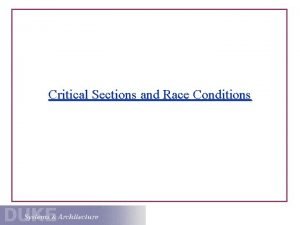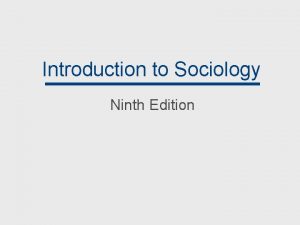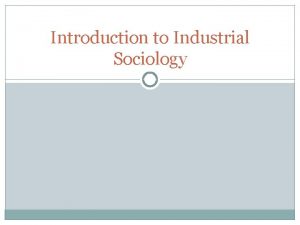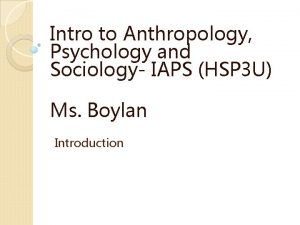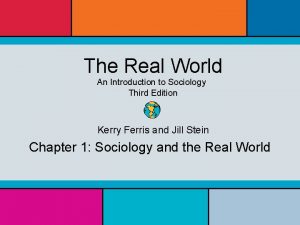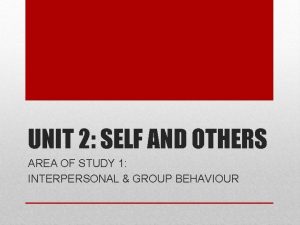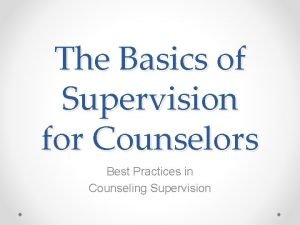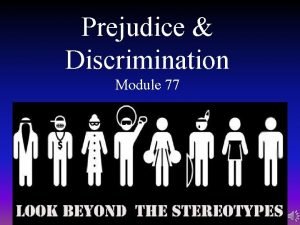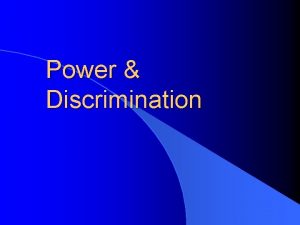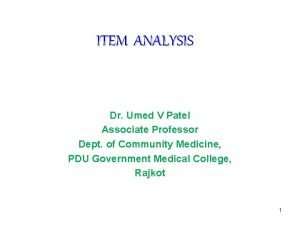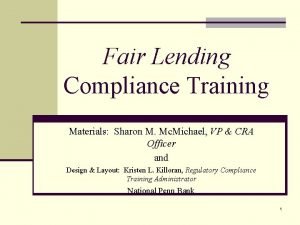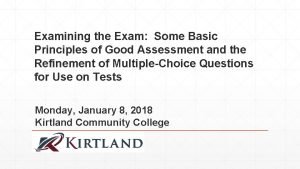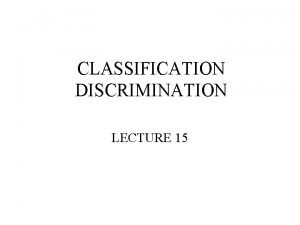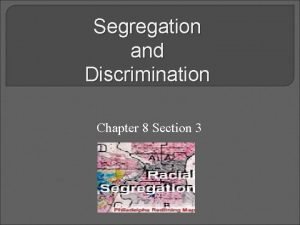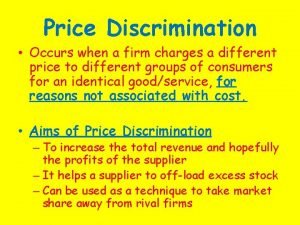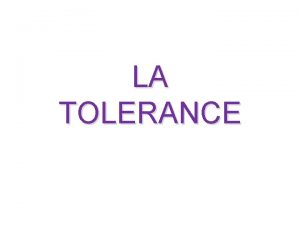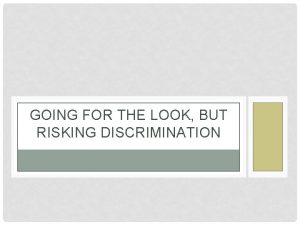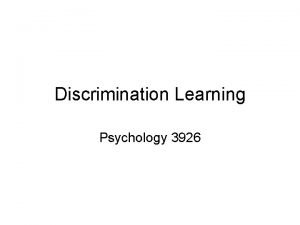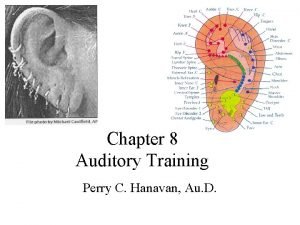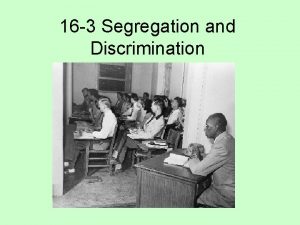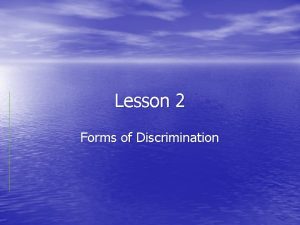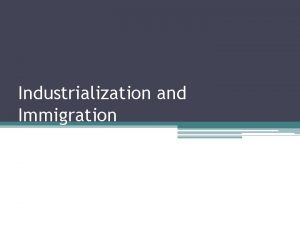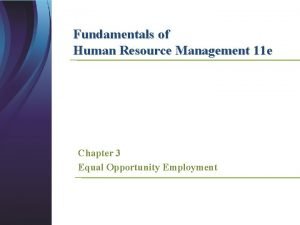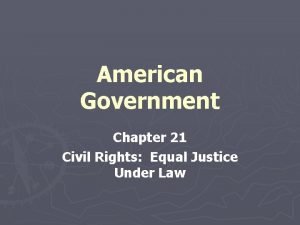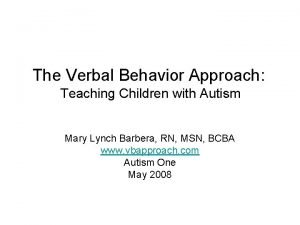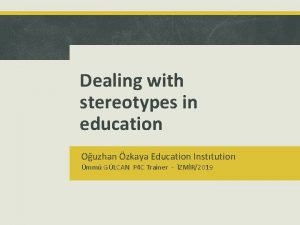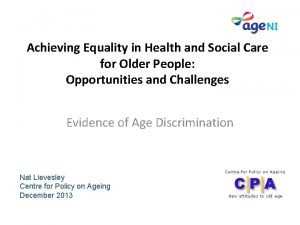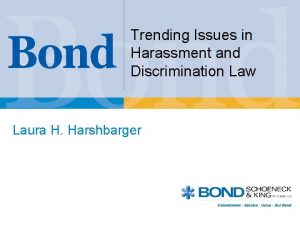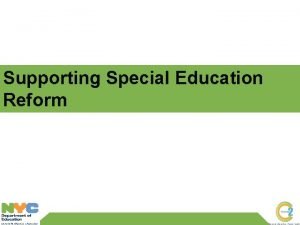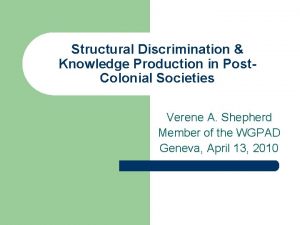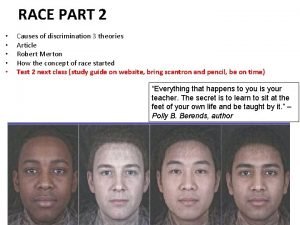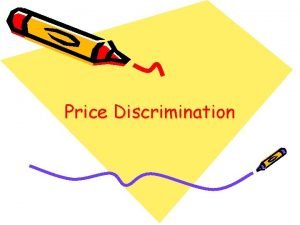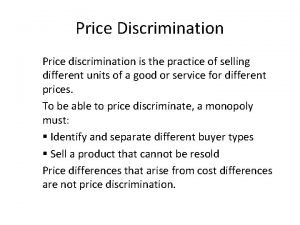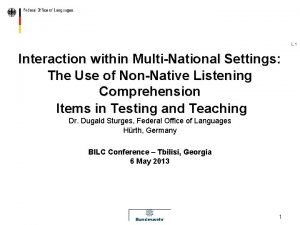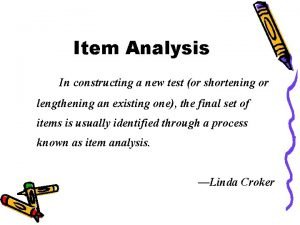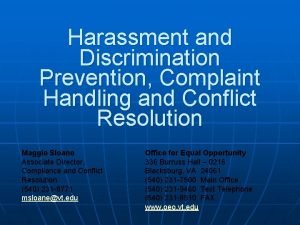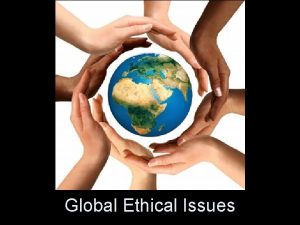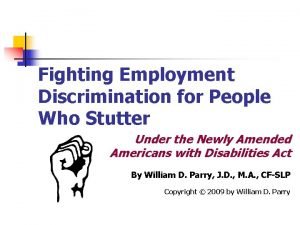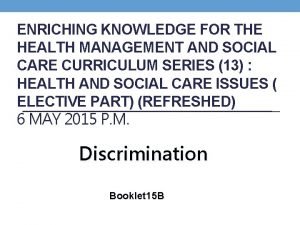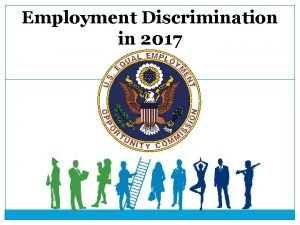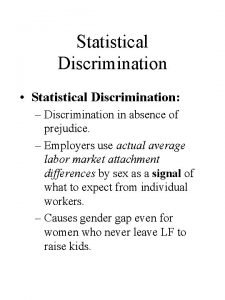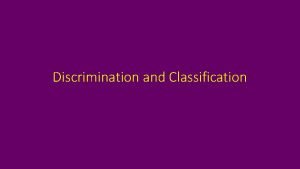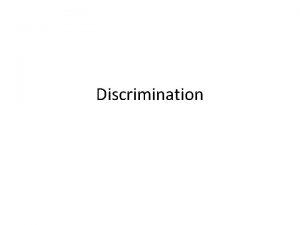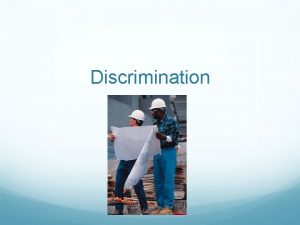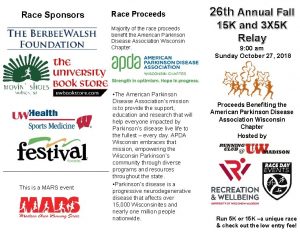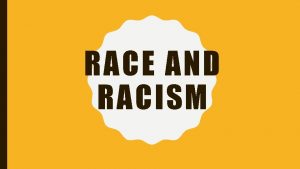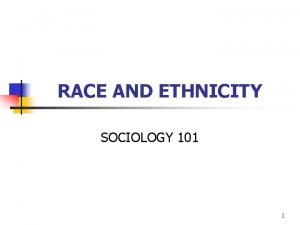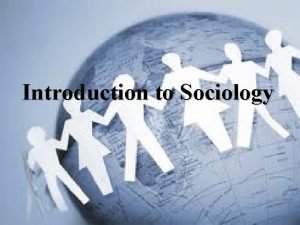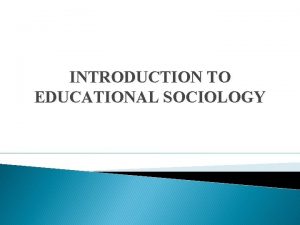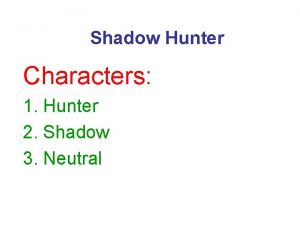Sociology of Race Discrimination Introduction to Sociology Hunter






















































































- Slides: 86

Sociology of Race & Discrimination Introduction to Sociology | Hunter College Jessie Daniels, Ph. D

Today • Race & Discrimination • Ch. 11 + Ta-Nehisi Coates, “The Case for Reparations” • KEY CONCEPTS: – What difference does race make? – How do sociologists measure race? – What is the difference between prejudice, discrimination and systemic racism? – What difference does “whiteness” make? – How do sociological theories explain racial inequality? – How has the U. S. approached race & reparations?

TO REVIEW

W. E. B. Du. Bois (1868 -1963)

Key Ideas

Double-Consciousness


what difference does race make?

Median Net Worth Varies by Race

Share of All Net Worth Varies by Race

Infant Mortality Varies by Race

Incarceration Rates Vary by Race




Marijuana Use about the Same by Race

Marijuana Arrest Rates Vary by Race


How do sociologists measure “race”?

How does the U. S. Census measure “race”?

Census Categories Then & Now Previous racial categories included: 2010 Census, Race Section 1790: Free white males Free white females All other free persons (included Native Americans who paid taxes and free blacks) Slaves 1890: ‘Mulattos’, Quadroons, Octoroons, Chinese, Japanese, 20 th century: “Hindu”, “South Americans” Census categories from other nations 21

22

Does the U. S. Census create “race”?

Some “racial” identities only exist in U. S.


Chinese, Korean, Japanese become “Asian”


Mexican, Cuban become “Hispanic”

So does the U. S. Census create “race”?

Only partially.


People demand changes to U. S. Census.

To reflect changing identities.


Key Idea: “racial identities” are fluid & change over time


But who can “declare themselves” white?

U. S. Supreme Court Rules on Race

who gets to be “white” & a “citizen”

Dred Scott v. Sanford (1857)

“no one of African ancestry could claim citizenship in the U. S. ”

The People v. Hall (1854)

“no one of the Chinese race can give evidence against a white man”

Ozawa v. U. S. (1922) Petitioned the court: have “Japanese” declared “white, ” and thus eligible for citizenship.

Ozawa v. U. S. (1922) Court ruled: the Japanese were “not free white persons" for purposes of naturalization

U. S. vs. Bhagat Singh Thind (1923) Court ruled: all Indian. Americans born abroad not eligible for citizenship because they are not a White person "in accordance with the understanding of the common man”


Exercise: Question why do people want to claim “whiteness”?


Prejudice, Discrimination, & Racism Term Definition Related Concepts Systemic Racism Set of laws, knowledge systems, everyday practices that are used to ensure the dominance of one racial/ethnic group over all others. White racial frame Institutionalized racism Discrimination Actions or practices of dominant group members that have a harmful impact on a subordinate group Covert vs. Overt Indirect vs. Direct Microaggressions Prejudice Negative attitude based on faulty generalizations about members of specific ethnic, racial, or other groups Stereotypes Ethnocentrism 50

How do sociological theories explain racial inequality?

Symbolic Interactionism • how do people define themselves along racial & ethnic lines? 52

Symbolic Interactionism • how do people define themselves along racial & ethnic lines? • how do daily encounters between people of different races make a difference? 53

Symbolic Interactionism • how do people define themselves along racial & ethnic lines? • how do everyday encounters between people of different races make a difference? 54

Symbolic Interactionism • contact thesis: more contact between people of different racial backgrounds increases tolerance 55

Functionalism • racism is merely a dysfunction (but the whole system is good)

Functionalism • racism is merely a dysfunction • assimilation: process by which members of subordinate racial and ethnic groups become absorbed into the dominant culture, through language, norms, customs and intermarriage. 57

Functionalism • racism is merely a dysfunction • assimilation: process by which members of subordinate racial and ethnic groups become absorbed into the dominant culture. • ethnic pluralism: coexistence of a variety of distinct racial and ethnic groups within one society. 58

assimilation < ---- > ethnic pluralism 59

Conflict Theory: Racism Persistent Feature

Resistance also a Persistent Feature

Conflict Theory • all of U. S. history is about the struggle of racial inequality, tied to global colonialsm. • caste perspective: views racial and ethnic inequality as a permanent feature of U. S. society. • class perspectives: emphasize the role of the capitalist class in racial exploitation. 62

Conflict Theory • all of U. S. history is about the struggle of racial inequality, tied to global colonialsm. • caste perspective: because racism is permanent, little progress is possible. • class perspectives: progress is only possible by eliminating class exploitation. 63

#Black. Lives. Matter

#Hashtag become a Movement

#Black. Lives. Matter

#Black. Lives. Matter

<3 stories about race & reparations>

<first story>

California Land Law (1913)

Anti-Japanese Racism during WWII

Systematic Displacement

Internment Camps, 1942 -1946


U. S. Reparations for Internment (1988)

<second story>

Centuries of Chattel Slavery

Decades of Lynching

Great Migration North: Fleeing Racial Terror

Tulsa, Oklahoma (1900 -1921)

U. S. Bombed Tulsa: Hundreds Killed, Displaced

<third story>

Native Americans Dispossessed of Lands

Exercise: Question why reparations for Japanese Americans but not others?

What should you do before next class?

1. COMPLETE MISSING ASSIGNMENTS! 2. Be sure you’ve read Ch. 11 in your text and the article by Ta-Nehisi Coates. 3. Reflect on this lecture and your notes. 4. Print the video worksheet for “The House We Live In” and bring it to class on Thursday.
 Joe hunter treasure hunter
Joe hunter treasure hunter Race-based discrimination occurs when _____.
Race-based discrimination occurs when _____. Data race vs race condition
Data race vs race condition Head race and tail race
Head race and tail race Design of dam
Design of dam Introduction to sociology 9th edition
Introduction to sociology 9th edition Scope of industrial sociology
Scope of industrial sociology Anthropology psychology and sociology
Anthropology psychology and sociology The real world an introduction to sociology
The real world an introduction to sociology Anthropology psychology and sociology
Anthropology psychology and sociology Introduction to sociology
Introduction to sociology Introduction to anthropology psychology and sociology
Introduction to anthropology psychology and sociology Sociology as a science essay
Sociology as a science essay Tischler sociology
Tischler sociology Prejudice in intercultural communication
Prejudice in intercultural communication Direct vs indirect discrimination
Direct vs indirect discrimination Passive discrimination
Passive discrimination Bernard discrimination model
Bernard discrimination model Bernard discrimination model
Bernard discrimination model Stimulus control occurs when
Stimulus control occurs when Bernard discrimination model
Bernard discrimination model What is discrimination
What is discrimination Peak load pricing
Peak load pricing Usually negative, _____ is an attitude or prejudgment.
Usually negative, _____ is an attitude or prejudgment. Discrimination power
Discrimination power Perfectly price discriminating monopoly
Perfectly price discriminating monopoly Two part tariff graph
Two part tariff graph Age discrimination act 2004
Age discrimination act 2004 Robert vischer empathy theory
Robert vischer empathy theory Item discrimination power
Item discrimination power Discrimination index formula
Discrimination index formula Avoiding discrimination through causal reasoning
Avoiding discrimination through causal reasoning Lending compliance training
Lending compliance training Discrimination index interpretation
Discrimination index interpretation Anti discrimination act qld
Anti discrimination act qld Discrimination vs classification
Discrimination vs classification Second degree price discrimination graph
Second degree price discrimination graph The age discrimination act 2004
The age discrimination act 2004 Zero discriminating power
Zero discriminating power Types of item analysis
Types of item analysis Chapter 16 section 3 segregation and discrimination
Chapter 16 section 3 segregation and discrimination Chapter 8 section 3 segregation and discrimination
Chapter 8 section 3 segregation and discrimination Price discrimination occurs when
Price discrimination occurs when Religious discrimination
Religious discrimination Brainstorming discrimination
Brainstorming discrimination Gordon allport scale of prejudice
Gordon allport scale of prejudice Going for the look but risking discrimination
Going for the look but risking discrimination Job discrimination
Job discrimination Discrimination learning psychology
Discrimination learning psychology Detection discrimination identification comprehension
Detection discrimination identification comprehension In what region did racial etiquette exist
In what region did racial etiquette exist Religious discrimination pictures
Religious discrimination pictures Lesson 2: racial discrimination
Lesson 2: racial discrimination Discrimination
Discrimination Religious discrimination pictures
Religious discrimination pictures Don tiburcio de espadaña el filibusterismo
Don tiburcio de espadaña el filibusterismo Diability discrimination act
Diability discrimination act Disability discrimination act in sport
Disability discrimination act in sport Government chapter 21 diversity and discrimination
Government chapter 21 diversity and discrimination Mary barbara autism conditional discrimination
Mary barbara autism conditional discrimination Anti discrimination act qld
Anti discrimination act qld Youtube.com
Youtube.com Anti discrimination act qld
Anti discrimination act qld Diversity and discrimination
Diversity and discrimination Age discrimination
Age discrimination Eeoc discrimination
Eeoc discrimination Special education discrimination
Special education discrimination Structural discrimination
Structural discrimination Merton's typology of prejudice and discrimination
Merton's typology of prejudice and discrimination Student discount price discrimination
Student discount price discrimination Student discount price discrimination
Student discount price discrimination Perfect price discrimination
Perfect price discrimination Objectives of price discrimination
Objectives of price discrimination Perfect price discrimination
Perfect price discrimination Versioning price discrimination
Versioning price discrimination Types of price discrimination
Types of price discrimination Percieved discrimination
Percieved discrimination Quantitative item analysis definition
Quantitative item analysis definition Employer employee relationship in hrm
Employer employee relationship in hrm Resolution of discrimination
Resolution of discrimination Spoken poetry examples
Spoken poetry examples Slogan about gender equality
Slogan about gender equality Stuttering and employment discrimination
Stuttering and employment discrimination Discrimination examples sentences
Discrimination examples sentences What are protected classes
What are protected classes 9 grounds of discrimination ireland
9 grounds of discrimination ireland Discriminative stimulus psychology definition
Discriminative stimulus psychology definition


